|
Location:
80 Km NW of Cuzco, Peru. |
Grid Reference:
13� 09' S, 72� 33' 20" W. |
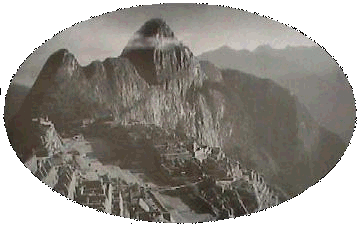
 Machu Pichu:
('The Old Peak').
Machu Pichu:
('The Old Peak').
Machu Picchu was one of the
few Inca sites that was not discovered by the Spanish during the conquest
of 1530.
This famous mountain citadel was
officially re-discovered in 1911 by Hiram Bingham. Very little is
known about the site, except that it has buildings that show strong
suggestions of solar observation (12). The structures are
built from white granite, with blocks reaching up to 3.7 metres in
length.
Skeletal remains show a 10:1 ratio of
females to males.
(2)
(Click
here for map of the site)
(Image
of Overgrown Machu Picchu by Bingham in 1912)
|
Machu Pichu (The Old Peak): |
There are nearly 200 rooms at Machu Picchu, including residences, temples,
storage buildings, altars, and observatories. There were also several
shrines for the practice of ancestor worship of the Inca, a religious cult in which centuries-old mummies of ancestors were kept
and tended. Doorways and walls were not necessarily rectangular in outline
or plan, but all fit together tightly. Evidence of several fires have been
discovered at Machu Picchu,
particularly in the area known as the Torreon, which was thought to have
held the mummy of Pachacuti himself. The fires were likely the work of the
Spanish, who attempted to obliterate the old Incan religion.
Structures at Machu Pichu:
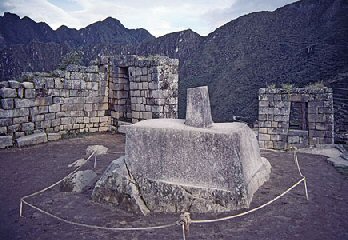
The Intihuatana:
(The Hitching Post, 'Saywa' or 'Sukhanka'
stone)
One of very few remaining stones sacred to the sun-god Inli; It is a small flattened pyramid topped by a huge stone sundial carved from
the natural rock. The name means �the hitching post of the sun�. The stone
was able to indicate equinoxes and lunar movements
(12). as at midday on March 21
and September 21, the equinoxes, the sun stands almost above the
pillar�casting no shadow at all.

The
Tower of the Sun:
Built around natural rock feature, this structure was roughly
shaped like a horse shoe (left), and has a trapezoidal window in it, which
appears to have been placed to permit observation of the mid-winter
solstice.
(12).

The
Temple of the Three
Windows:
So
called because of its three trapezoidal windows. A short distance away from
the windows, in the middle of the Temple, stands a rectangular stone which
is suspected of having been used as a back-sight for solar observations.
(12).

The 'Royal Tomb'
� Carved from solid granite, the tomb lies directly below
the Tower of the Sun. A throne of solid rock walls with carefully worked
stone slabs.
(12). This fantastic construction
served as a tomb of an important person. (And from here came
the name). On the right side one can see the rock carved with three steps
(the symbol of the Pachamama). The rock was harmoniously united with the
great rock that supports the Temple of the Sun. The internal walls of the
grotto in the Royal Tomb are covered by stones that are perfectly joined and
in these walls there are four trapezoidal niches, the size of doors.
The Inca were masters at dry-stone walling with granite
blocks, using a technique called ashlar,
in which blocks of stone were cut to fit together tightly without mortar.
Although they were able to
create whole citadels such as Machu Picchu with its intricate block-work, no tools have been found that explain how.
It is rumoured the Inca had knowledge of a plant that could 'dissolve'
stone.
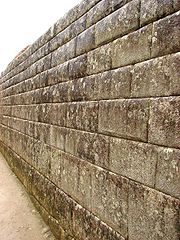
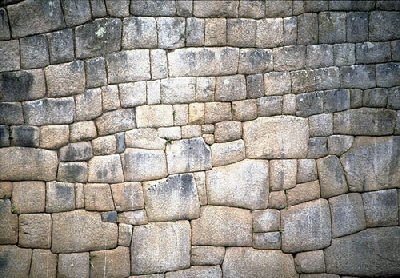
Examples of the masonry at Machu picchu - much of which is so good that a
peice of paper cannot be slid between the blocks.
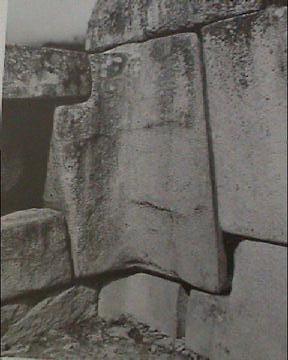
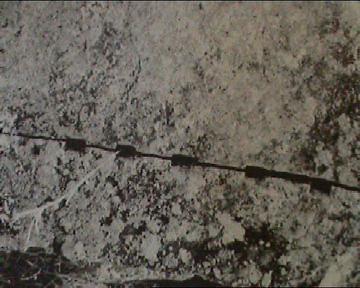
These construction techniques are
identical
to those found
at other sites from around the ancient world.
(Similar construction techniques
from around the ancient world)
|
Asuka Village:
Japan.
The
mountainous Nara prefecture of Japan is home to the
following structures. Perhaps coincidence, but they bear
a striking similarity to the masonry at Machu Pichu as
the following images testify:

Rhomboid shaped cavity.
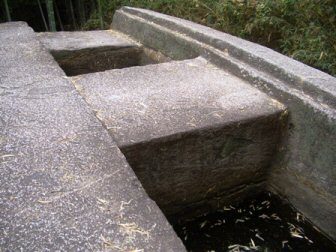
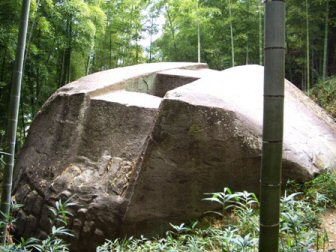
'Hitching Stone?' near the top of Iwafune Mountain.
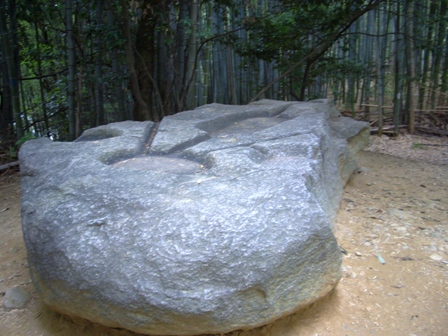
The
channels in the rock above are similar to those found at
Sacsayhuaman.
Photo
Credits and More Information:
http://www42.tok2.com/home/slicer190190/5-37.html
|
Chronology of Machu Pichu:
In the 1930�s, Prof Rolf Muller,
controversially concluded from the alignments of the buildings, and using
the procession of the equinox as a slide-rule, that the site could have
only been built during �the
era of 4,000 BC to 2,000 BC.
(21)
Today it is considered to have been
built around the year 1,460, but was abandoned as an
official site for the Inca rulers a hundred years later, at the time of
the Spanish conquest around 1530 AD.
Archaeo-astronomy:
The site appears to demonstrate several astronomical
orientations in the structures, including solstice, equinoxes and lunar
movements.
The Intihuatana stone (meaning
'Hitching Post of the Sun') has been shown to be a precise indicator
of the date of the two equinoxes and other significant celestial
periods. The Intihuatana (also called the Saywa or Sukhanka stone)
is designed to hitch the sun at the two equinoxes. At midday on
March 21st and September 21st, the sun stands almost directly above
the pillar, creating no shadow at all. At this precise moment the
sun "sits with all his might upon the pillar" and is for a moment
"tied" to the rock. At these periods, the Incas held ceremonies at
the stone in which they "tied the sun" to halt its northward
movement in the sky. There is also an Intihuatana alignment with the
December solstice (the summer solstice of the southern hemisphere),
when at sunset the sun sinks behind Pumasillo (the Puma's claw), the
most sacred mountain of the western Vilcabamba range, but the shrine
itself is primarily equinoctial.
The 'Wayna Picchu 'Face'.
It has been observed that the outline of the Wayna Picchu mountain resembles a face. Whether or not this was the
original reason
for the placement of Machu Picchu is a controversial issue. The photo on the
left is original while the photo on the right was treated for a coffee
advert to highlight the natural features.
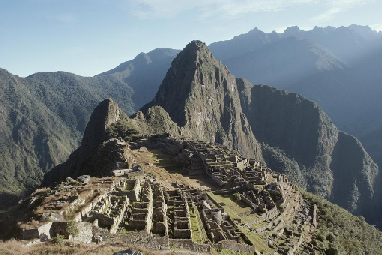 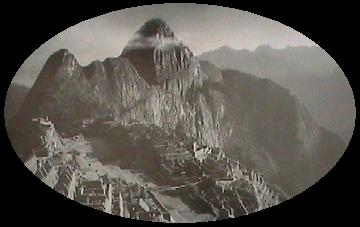
Other
Macchu Facts.
Partway down the northern
side of Wayna Picchu (The Young mountain), is the so-called "Temple of the
Moon" which consists of a set of architecturally enhanced caves.
At Torontoy, one of the smaller sites clustered around Machu Pichu,
there is a stone with 40 angles between the sides.
(12)
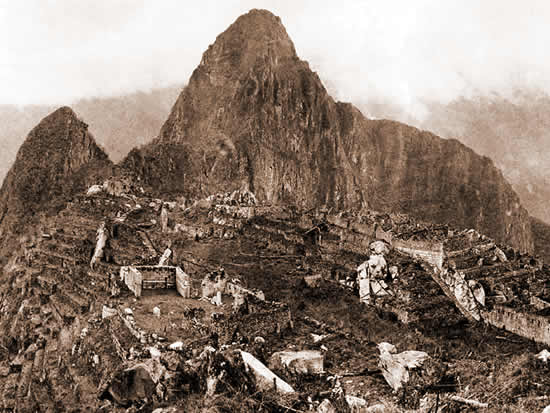
Photo of Machu Picchu, turn of 20th
century. (Credits: National Geographic, 1912)
|















